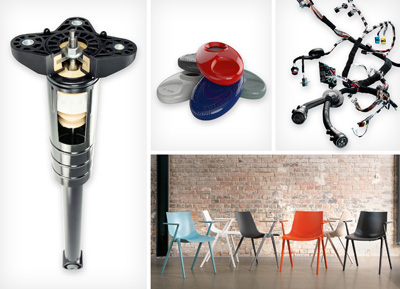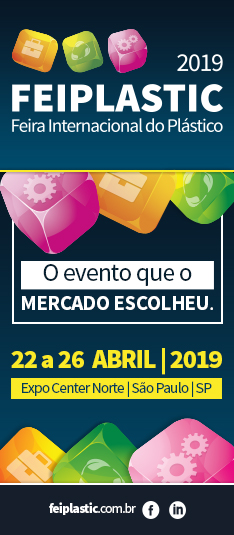| Plastics News |
BASF showcases a variety of new products at Fakuma
When the doors open on the 26th Fakuma in Friedrichshafen, Germany, from October 16 until 20, BASF will be showcasing its latest developments from its portfolio. The international trade fair for plastics processing will see BASF experts discussing the current market trends in the automotive, lifestyle and industrial development sectors. Many new products and innovations will be presented at stand 4306 in hall B4. Ultramid® Deep Gloss now in color: The development of the specialty polyamide Ultramid Deep Gloss continues to make progress. After having been successfully launched on the market and winning the German Innovation Award, the product now turns from black to colorful. “In order to meet the individual needs of our customers, we are now also able to offer Ultramid Deep Gloss in colors. Apart from contrasting colors, we are also offering colors which follow current color trends. This opens up versatile possibilities for car interior design,” said Xaver Hopfenspirger, project manager for Ultramid Deep Gloss at BASF. The company says that its property profile remains unchanged: resistance to scratching, high chemical and good UV resistance. In addition, the high gloss level reproduces structures with faithful detail, thus allowing a highly contrasting mix of light and shadow – without additional coating. High-performance materials for autonomous driving Chemistry is making a vital contribution to the comfort and safety of autonomous driving. Sensors in the car are important in assisting the driver and are an indispensable part of the development of autonomous driving. Whether these are radar, lidar, IR or ultrasonic sensors, they function not only as lane assistants but also as collision warning systems and distance control, and assist with the emergency brake function – a basic prerequisite for controlling cars completely automatically in the future. With its range of products, such as the hydrolysis resistant polybutylene terephthalate (PBT) Ultradur HR and the polyamide (PA) Ultramid EQ for sensitive electronic applications, BASF is already contributing to a large number of sensor technologies and playing a valuable role in making autonomous driving a reality. Engineering plastics and polyurethanes increase driving comfort: Automotive manufacturers are always keen to reduce the effects of non-suspended parts on the chassis and to protect the car occupants from disturbing bumps. Weight reduction, driving comfort, NVH solutions (NVH: Noise, Vibration, Harshness) – there is a wide range of requirements on chassis components. BASF says that, in order to allow automotive manufacturers to achieve the optimum combination of lightweight construction, pleasant acoustics and vibration damping, it provides NVH solutions made from the microcellular polyurethane elastomer Cellasto® as well as the highly glass-fiber reinforced polyamide Ultramid and the thermoplastic polyurethane Elastollan®. This results in efficient material combinations for top mounts, spring seats and other chassis components. E-mobility with Elastollan: The mechanical properties of Elastollan and its resistance to fats and oils make the thermoplastic polyurethane (TPU) from BASF a partner in the field of e-mobility. BASF says that, due to their flexibility and UV resistance, several polyether polyol-based Elastollan grades of the 1100 and 1100 FHF/FR series are suitable for use in the sheaths of charging cables (ISO 6722 certification – class C and class D), whether for mobile charging from the luggage compartment or at a charging station. In addition, these non-halogen-based, flame-retardant Elastollan grades offer customers good processing characteristics and consistently high quality, the manufacturer claims. Optimized connectors for the automotive industry: BASF is expanding its portfolio of engineering plastics and continuing to answer the trend of miniaturization of electronic car components: the new Ultradur grade B4340ZG3, with its improved mechanical properties and increased impact strength, offers increased stiffness and resistance to external loads, while retaining the same excellent flowability, the company says. Applications such as cable harnesses require robust and unbreakable plug-in connectors to avoid the labor- and cost-intensive replacement of defective parts. Ultradur B4340ZG3 also has special electrical properties. BASF says that the CTI (Comparative Tracking Index acc. to IEC 60112) is 600 volts and therefore permits minimum gaps between the conductor tracks in plug-in connectors. Ultradur B4340ZG3 is available in black and uncolored from now on in commercial quantities; samples can be ordered. Crystal clear decision for Elastollan: BASF says that its aliphatic Elastollan series L 700 and L 1200 convinces with its optical properties and mechanical toughness. When it comes to preserving delicate surfaces as part of stone chip protection in cars or erosion protection in wind turbines, the use of Elastollan films is recommended. According to the company, these materials also offer a combination of crystal clear transparency, long-term UV resistance and strong mechanical properties in other demanding applications such as TPU laminate films in high-security glass for vehicles and buildings. Infinergy scores well in the sports sector: In 2013, Infinergy (E-TPU) was launched in the adidas Energy Boost shoe. Today, Infinergy is also popular in other sports applications. At the BASF stand, the material will be exhibited not only in the adidas shoes but in applications such as bicycle saddles, bicycle tires, treadmills and other sports equipment. The closed-cell particle foam’s properties makes it suitable for a variety of sports applications. According to BASF, the material provides both cushioning and spring, and is therefore ideal for sports that put intense stress on joints. The high rebound effect is achieved by the special air cell structure made from welded foam beads. Infinergy is also lightweight and elastic, the company states. The expanded thermoplastic polyurethane is thus opening up entirely new areas of application both inside and outside the sports sector. Take a seat! Seating at stand provided by lightweight Aula from Wilkhan: Aula is the name of the latest chair model from Wilkhahn. The fully plastic frame and the armrests are made from Ultramid SI, the surface-optimized plastic from BASF. With this chair, designers and engineers have taken plastic to new esthetic and functional dimensions. BASF says that its simulation capabilities (Ultrasim®) also played a key part in ensuring that every part of the chair frame could be produced from a high-performance plastic, therefore rendering a steel core unnecessary. This resulted in a new weight class. At only 6 kilograms, or 6.7 in the design with armrests, the Aula is a lightweight. Color masterbatches from BASF Color Solutions: With its masterbatch for regranulate overdyeing, BASF Color Solutions Germany GmbH is also presenting products to strengthen the concept of sustainability this year. To this end, the two variants “coloration of natural plastics” and “coloration of recycled material” are being presented as equivalent alternatives. The variants are presented embedded in artificial turf that has been dyed using the product lines Lufilen® und Sicolen® and manufactured by Beens Grass-Yarns B.V. Using artificial turf instead of real turf can make a valuable contribution to sustainability in arid regions, since this saves the limited resource of water. The possibility of dyeing recycled material to produce a high-quality finish reinforces the recycling of materials in a circular economy. It is even possible to dye materials containing up to 100% recyclate, since the color-intensive Sicolen masterbatches manage to overcome the usual challenges of recyclate coloration using special additives. Possible examples are beverage crates and waste bins, that can therefore bear the “Blue Angel” eco-label. Source: BASF |


